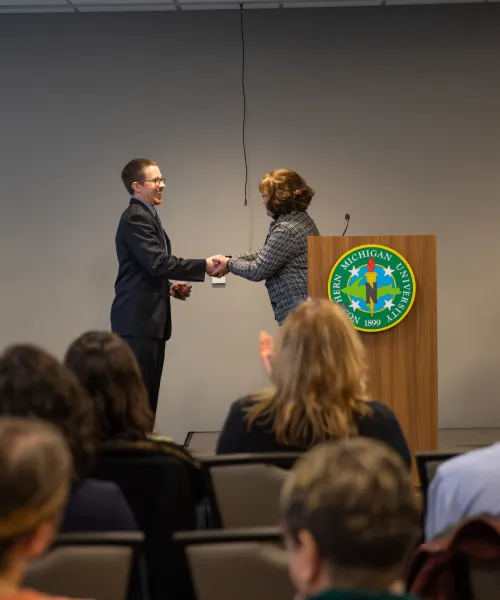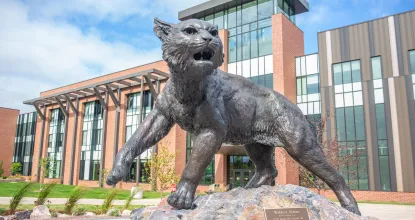
The Academic Affairs and Student Success Division is strongly committed to enhancing the pursuit of scholarship by faculty and staff. We are committed to the concept of the teacher-scholar, a distinction that was emphasized by Ernest Boyer when he said that the time has come to move beyond the teaching versus scholarship debate.
Teaching and Scholarship
Teaching and scholarship are two sides of the same coin; as stated in the summary of our recent report on scholarship at NMU, Faculty scholars bring innovation to the classroom to enhance teaching.
Boyer's Four Forms
Like many academic institutions across the U.S., NMU recognizes Boyer's four forms of scholarship:
- Discovery
- Integration
- Application
- Teaching
Grants and Reserach
The Grants and Research Office facilitates grant proposal writing and submission by NMU faculty and staff. Many internal grant opportunities exist for faculty to pursue, including curriculum development and instructional improvement awards, faculty grants, and the prestigious Peter White Scholar Award. Individual colleges also provide scholarship support.

Share your research!
If you are a faculty member conducting research at NMU, we want to hear about it! To better highlight the amazing research happening on our campus, we have created a form to share what you are working on. This form is sent directly to the Office of Sponsored Programs, Marketing and Communications, and Academic Affairs and Student Success
Faculty Research Features

Robbie Goodrich, Professor, History
What do you research at NMU? Please share your research and most significant professional accomplishments.
Most of my research focuses on constructing a modern identity in German-speaking Europe. Initially, I looked at Catholic workers from the Rhineland in Imperial Germany (1871-1918). However, I shifted my focus to the Austro-Hungarian Monarchy during that period. While I did recently publish a book dealing with the collapse of democracy in Germany in the early 1930s, I also write on how citizens of Austria-Hungary and their descendants thought and think about what it meant to be part of a multi-ethnic empire, especially in a century dominated by nationalism. Both of these research fields led me quite obviously to how Jews thought of themselves and were thought about in this era, which inevitably led me to work closely with issues of the Holocaust and, from there, to comparative genocide. My most recent research is on Ruthenians, both in Austria-Hungary and as immigrants in Michigan. And since almost no one knows what a Ruthenian is, everyone will just have to read my articles...
Why did you come to NMU and why did you decide to stay?
After graduating from graduate school, I had a one-year position, and then NMU offered me a tenure-track position. I fully appreciated all that NMU had to offer professionally - supportive colleagues, exciting students, and research funding. NMU also gave me the opportunity to create the faculty-led study abroad Vienna Program, which I started with colleagues in 2001. In this program, I get to share my interest in Central Europe with students who are often right where I was when I was about 20 - not really sure about all the opportunities there are out there, but open to something new.
What are your future research plans?
I am currently finishing up the second article on Ruthenians (this one focuses on their experience as immigrants in the US). After that, I plan on starting a new project related to the Reacting to the Past series (these works are a mix of research and pedagogy that provide students with an immersive, student-centered learning experience based on primary sources around a particular topic). Following up on my book about the collapse of the Weimar Republic, I have been doing preliminary work on the subject of the Evian Conference in 1936 (this was the international meeting that attempted but failed to address the growing Jewish refugee crisis). This topic would serve as a bridge between my areas of interest.

Sylvain Giroud, Assistant Professor, Biology
What do you research at NMU? Please share your research and biggest professional accomplishments.
As an Animal Ecophysiologist, my research focuses on the behavioral, physiological, and molecular mechanisms enabling animal species to manage their energy balance hence to cope with environmental fluctuations in an ecological and evolutionary context. A particular interest lies in how heterothermic endotherms, especially hibernators, respond to environmental variations triggered by global changes, including global warming. My research further contributes to environmental health issues by developing a biomimicry approach, which consists of being inspired by natural adaptations of species to fuel new ideas for humans and other domesticated species. One of my biggest professional achievements has been to unravel the underlying mechanisms of the hibernation phenotype across species of various body sizes, from small heterotherms, including dormice and hamsters, to large hibernators, such as bears.
Why did you come to NMU and why did you decide to stay?
NMU has been an attractive place for me as it combines both a student-centered education and the development of high-quality research, notably in Biology. The unique location of the Upper Peninsula allows for the establishment of a robust research program at the intersection of Wildlife Ecology, Physiology, and Evolution. Further, the broad interest of the Biology Faculty, ranging from Molecular & Cellular Biology to Population Ecology and Ecosystems, offers excellent possibilities for studying system organisms across multiple levels of organization, i.e., molecular, cellular, organismal, and population-wide. This will enable a variety of research topics on which many undergraduates and graduates can embark on multiple projects, providing students with unique and extraordinary research experiences.
What are your future research plans?
My academic vision is to establish and develop an outstanding research program centered on the Ecophysiology of hibernation to understand hibernators’ unique ability to cope with environmental fluctuations by studying small to large species in the context of climate change and global warming. I am particularly interested in studying the phenotypic (in)flexibility of the seasonal hibernation and reproduction cycles and their consequences for individuals’ lives and future generations in species of contrasted hibernation behaviors. The Thirteen-Lined Ground Squirrel (Ictidomys tridecemlineatus), a fat-storing species that does not feed during hibernation, and the Eastern Chipmunk (Tamias striatus), a food-storing hibernator that feeds on food caches during winter, constitute unique models for studying the effects of global warming on the seasonal cycle of hibernation and reproduction. How do climate change and global warming affect hibernation efficiency and phenology, and what are the consequences and the involved mechanisms of such on individuals’ life history traits and future Generations?

